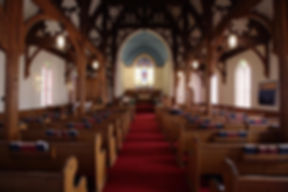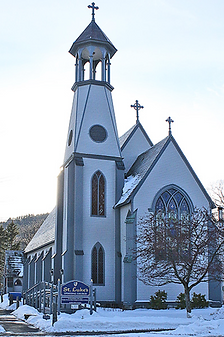

St. Luke's Episcopal Church
313 Main Street
Chester, Vermont 05143
(802) 875 - 6000
followed by Coffee Hour

The History of St. Luke's Episcopal Church
Chester, Vermont
Reprinted from St. Luke’s Centennial Celebration Booklet, November 1968
In the latter part of the year 1867, the Rev. Charles Stuart Hale, Rector of Immanuel Church, Bellows Falls, came to Chester and conducted an evening service in the Congregational Meeting House – this being the first Episcopal Service held in Chester. As succeeding services were held, interest was awakened, and an earnest desire for permanent services, leading to the formation of a “Ladies’ Sewing Society”, and later to “St. Philip’s Mission.”
An effort was then made to secure a missionary and to raise sufficient funds to support him. Between four and five hundred dollars were pledged, and four hundred dollars was promised by the Missionary Board of the Diocese of Vermont.
Encouraged by this success, a call was extended to the Rev. Alonzo B. Flanders, of the Diocese of New Hampshire, which he accepted for one year. The Rev. Mr. Flanders moved to Chester in March of 1868, as the resident missionary. Services were held on the third floor of the Chester Academy, located on the site of the present Junior High School. On Easter Day, April 12, 1868, a parish was organized under the provisions of the old Canons of the Diocese, to be known as St. Luke’s Parish, with Merrick Wentworth and Clements Leland as Wardens, and with ten communicants. On September 5, 1868, Bishop Bissell visited the parish and confirmed five persons.

Frederick E. Fullerton generously offered to donate a building site and to subscribe one thousand dollars. Plans for a church were drawn and given to the parish by P. Wentworth, an architect in Boston. All these plans came to an abrupt halt with the sudden death of Mr. Fullerton, at the age of 52, in February of 1869. But Mrs. Fullerton immediately informed the Vestry that it was her intention to carry out the plans of her husband. With this assurance, work was begun on the church. The house, located on the lot where the church now stands, was moved away by 16 yoke of oxen, and the foundation of the church was started. It soon became apparent that the building, as planned by the architect could not be built with the available funds and the work stopped. The Rector was able to raise only a few hundred dollars outside the parish to continue the construction. Again Mrs. Fullerton informed the Vestry of her desire to see the church completed and promised the money needed to do so. Work on the church was resumed and the building was completed in the spring of 1872, at a cost of $15,000, including all the furnishings and the organ which is still being used. Of the total cost, Mrs. Fullerton contributed $11,000. The Rectory, located on High Street, was also a gift of the Fullerton Family.

St. Luke’s church was consecrated in May 1872, by the Rt. Rev. William Henry Augustus Bissell, D.D., the second Bishop of Diocese of Vermont. The preacher at this service was the Rt. Rev. Thomas M. Clark, Bishop of Rhode Island.
This church building has served the congregation of St. Luke’s Parish for the past 100 years.

Oil heat replaced the wood burning furnaces, for which wood had been supplied from the wood lots of the members of the parish and “wood-cutting bees.” For several years, Sunday services were held in Willard Hall during the winter months, when in 1960 changes in the heating system made it possible to heat the main part of the church. A recent gift from Frederick Fullerton Wiley enabled the parish to make further renovations in Willard Hall, adding folding doors to the classrooms. What may have been the original carpeting in the church was replaced in 1962.
Lacking any parish hall facilities, the annual meetings, church suppers, and social gatherings, and sometimes the Sunday services during the winter months were held in Wiley Hall, over the L. A. Carpenter Store next door to the church, and made available to the parish by the generosity of Susan Fullerton Wiley. A bequest by Miss Pearl Willard in 1949 made it possible to finish excavating the basement of the church to provide a meeting hall with kitchen facilities, class rooms, and a chapel.
The Rev. Alonzo Flanders continued as Rector of St. Luke’s for fourteen and a half years, the longest time of any of its rectors. Gethsemane Church in Proctorsville was organized during this period, 1890, and was served by the Rev. Mr. Flanders and his successors until 1947, when this Mission was served from St. Mark’s Church, Springfield. From 1925 to 1947, the Rector of St. Luke's was in charge of the three
Churches - Gethsemane and St. Mark’s, in addition to the parish in Chester.

In 1947, Donald Aspden, a licensed Lay Reader conducted services at St. Luke’s Church under the direction of the Rev. Robert S. Kerr, Rector of Immanuel Church, Bellows Falls. Mr. Aspden soon became a candidate for Holy Orders, studying with the Examining Chaplains of the Diocese, and was ordained to the Diocanate in St. Luke’s Church by the Rt. Rev. Vedder Van Dyck, Bishop of Vermont, on Ascension Day, May 22, 1952. As Lay Reader and Deacon-in-Charge of St. Luke’s, Donald Aspden worked with great devotion in building up the parish, until his death in May 1953, just before he was to be ordained to the Priesthood.


At this time, St. Luke’s became a mission of Immanuel Church, Bellows Falls, with their assistant, the Rev. John M. Mills, serving as Priest-in-Charge of St. Luke’s, but living in Bellows Falls until 1955, when he moved into the Rectory in Chester, which had been rented since 1942.
The present Rector, the Rev. Warren E. Fowler, also was assistant at Immanuel Church from 1956 to 1961, when St. Luke’s was no longer connected with Immanuel Church.
At this same time, Gethsemane Church in Proctorsville again became part of the responsibility of the Rector of St. Luke’s.
As St. Luke’s Church enters its second hundred years, may the love and devotion of her members for God and His Church continue the witness of past generations.